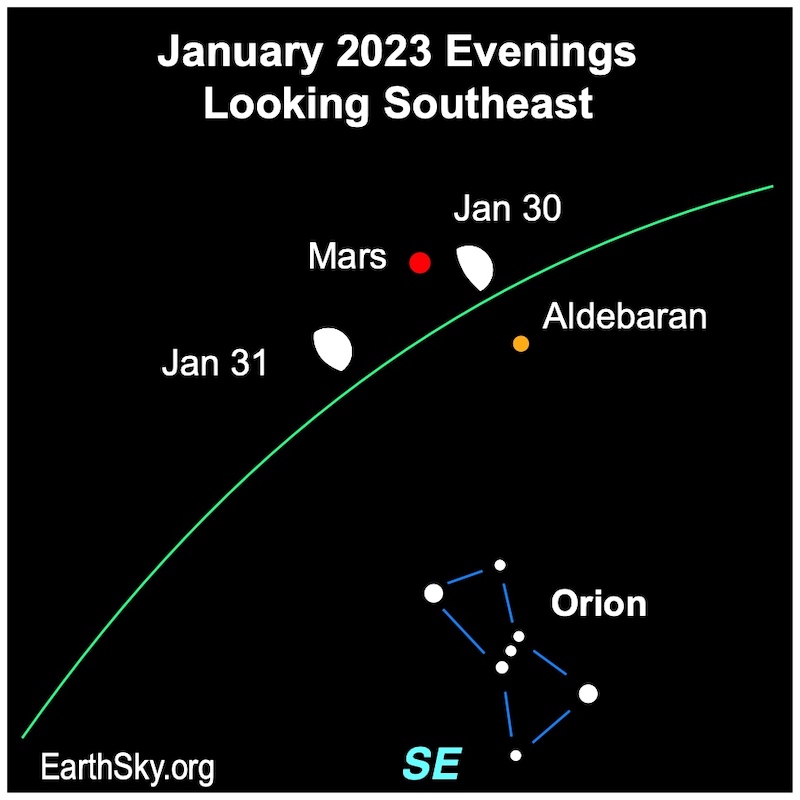
Our charts are mostly set for the northern half of Earth. In order to see a precise view from your location, try Stellarium Online.
See the moon near Mars
The moon will be passing by Mars on the nights of January 30 and 31, 2023. Mars has a roughly two-year cycle of visibility in our sky. And, for much of that cycle, it’s faint and inconspicuous. But – for a period of about six months, every couple of years – Mars brightens and appears quite red. It happens around the time Earth is passing between Mars and the sun. And that’s what happened in December 2022.
We passed between the sun and Mars on December 8, 2022, when Mars reached opposition. So, we’re racing away from Mars now, in our smaller, faster orbit. As a matter of fact, right now Mars appears as big and bright as it will for the rest of the year. That’s because Mars has faded from its recent opposition at magnitude -1.9 to its current magnitude 0. While that is still brighter than most stars, Mars will continue to fade the rest of 2023.
The stars near the moon and Mars
The reddish star near Mars is Aldebaran, the Eye of Taurus the Bull. Aldebaran can guide you to a V-shaped star cluster known as the Hyades. Also, the delicate star cluster of the Pleiades shimmers nearby with Orion the Hunter lower in the sky.
Plus, a lunar occultation of Mars
Parts of the globe will be treated to a lunar occultation of Mars at 4 UTC on January 31, 2023 (10 p.m. CST on January 30). It is visible in southern North America among other places. Check In-The-Sky to see if the occultation is visible where you live.
See pictures here of the lunar occultation of Mars on December 7, 2022
Bottom line: Watch for the moon near Mars from dusk until after 3 a.m. local time on the nights of January 30 and 31, 2023.
The post Moon near Mars January 30 and 31 first appeared on EarthSky.
from EarthSky https://ift.tt/fJM7IG8

Our charts are mostly set for the northern half of Earth. In order to see a precise view from your location, try Stellarium Online.
See the moon near Mars
The moon will be passing by Mars on the nights of January 30 and 31, 2023. Mars has a roughly two-year cycle of visibility in our sky. And, for much of that cycle, it’s faint and inconspicuous. But – for a period of about six months, every couple of years – Mars brightens and appears quite red. It happens around the time Earth is passing between Mars and the sun. And that’s what happened in December 2022.
We passed between the sun and Mars on December 8, 2022, when Mars reached opposition. So, we’re racing away from Mars now, in our smaller, faster orbit. As a matter of fact, right now Mars appears as big and bright as it will for the rest of the year. That’s because Mars has faded from its recent opposition at magnitude -1.9 to its current magnitude 0. While that is still brighter than most stars, Mars will continue to fade the rest of 2023.
The stars near the moon and Mars
The reddish star near Mars is Aldebaran, the Eye of Taurus the Bull. Aldebaran can guide you to a V-shaped star cluster known as the Hyades. Also, the delicate star cluster of the Pleiades shimmers nearby with Orion the Hunter lower in the sky.
Plus, a lunar occultation of Mars
Parts of the globe will be treated to a lunar occultation of Mars at 4 UTC on January 31, 2023 (10 p.m. CST on January 30). It is visible in southern North America among other places. Check In-The-Sky to see if the occultation is visible where you live.
See pictures here of the lunar occultation of Mars on December 7, 2022
Bottom line: Watch for the moon near Mars from dusk until after 3 a.m. local time on the nights of January 30 and 31, 2023.
The post Moon near Mars January 30 and 31 first appeared on EarthSky.
from EarthSky https://ift.tt/fJM7IG8

Aucun commentaire:
Enregistrer un commentaire